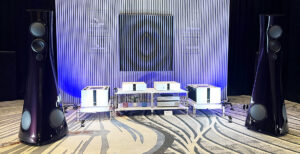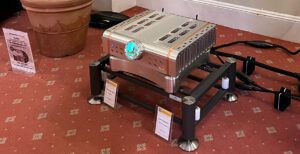
Sometimes I am asked by people not involved in high-end audio about what I do, and once I explain the basics of the field to them one of the most frequent comments I hear goes something like this: “I simply cannot believe that there are people out there willing to spend so much of their hard-earned money on hi-fi.” Welcome to my world.
The plain-as-day message to me is that what while many of us are accustomed to and—to a point—willing to embrace or at least tolerate contemporary high-end audio product prices, a very large number of our friends, neighbours, and acquaintances probably think that we are off of our collective rockers.
It also seems obvious to me that what’s needed are new products whose performance/price ratios are so compelling as to convince all but the most stubborn curmudgeons that the components in question are worth their asking prices—and then some. I’m talking, here, about products that, whether modestly or not-so-modestly priced, do so much that is musically right and good and engaging to both mind and soul that they simply leave listeners slack-jawed and wondering, “How does that manufacturer do it for the money?”
A reasonably wise man—OK, it was Antony Michaelson, Managing Director of the British firm Musical Fidelity—once observed to me that,
“The value proposition of any serious high-end audio component must be self-evident.”
I think he is absolutely right: When we hear a new component for the first time, something about the listening experience had better convince us the product is worth its asking price. (If not, then one must certainly question whether the product will enjoy long-term viability in the marketplace.) Happily, at the recent 2014 Rocky Mountain Audio Fest, I had the opportunity to sample several systems that passed the “Self-Evident Value Proposition” listening test with flying colours. Let me give you thumbnail sketches of several that caught my ear.
GoldenEar Triton One loudspeakers powered by Marantz electronics
As followers of the Hi-Fi+ newsletter already know, our magazine has a review in process on the remarkable GoldenEar Triton One loudspeakers (£5,000/pair), and as our preliminary blog on the Triton Ones indicated, they offer terrific value for money. This fact was driven home with added force at RMAF where GoldenEar teamed with Marantz to provide a demonstration that showed just how good an affordably priced audio system could really be.

While the room tended, in my view, to have only a small handful of genuinely excellent ‘sweet spots’ from which to listen, those lucky enough to spend time in those seats were treated to a serious high-end performance tour de force sourced from a system that—let us now heave a collective sigh of relief—did NOT cost the proverbial arm and a leg.
The system, as heard from those front-row centre seats, could really do all things well: full-range frequency response, macro and micro dynamics, 3D soundstages, pinpoint imaging, and brilliant tonal colours—the works. Indeed, one visitor to the room reportedly exclaimed, “This system makes many of the high-priced offerings at this show seem just plain silly!” Quite honestly, the man was not wrong in that assessment.
PSB Imagine T3 loudspeakers powered by NAD electronics
Paul Barton, founder and chief designer for the Canadian speaker manufacturer that uses Paul and his wife Sue’s initials for its name, took RMAF as the opportunity for launch his most ambitious loudspeaker to date: namely, the Imagine T3 floorstander, priced at $7500/pair (UK prices were yet to be determined at the time of the show).
The Imagine T3, like all of Barton’s designs, leverages the man’s vast experience in gathering and interpreting loudspeaker performance measurement data taken at Canada’s National Research Council acoustics labs. But Barton is far more than a cut-and-dried ‘design-by-the-numbers’ man; instead, he balances his designs with a wealth of critical listening experience that helps to fill in the gaps between what lab measurements can reveal as compared to what the ear can hear. The result is a speaker that’s very, very special indeed.
At first glance, the Imagine T3 could be misread as nothing more than “a bigger version of PSB’s Imagine T2”, but the closer one looks (and listens) the more obvious it is that the T3 has evolved in a new direction all its own. The T3 will replace Barton’s previous high-water mark design, the critically acclaimed Synchrony One loudspeaker, and Barton says the new T3 can outperform its predecessor in every way—most notably by producing significantly lower distortion than the already excellent Synchrony One.

Ably complementing the Imagine T3 were a set of NAD’s latest generation Masters Series electronics, including a very significant new Class D power amplifier based on the core technology of Hypex’ famous nCore Class D module (though by special licensing arrangement, NAD builds it own nCore-based modules, rather than using off-the-shelf Hypex units).

The net result, and I know this might seem underwhelming at first read, was a system—and in particular a loudspeaker—that in all key performance areas simply sounded “right” (very right) from the outset. But, as was the case in the GoldenEar/Marantz room mentioned above, there were some seats in the PSB room more special than others. From those extra-good seats, I was floored by the amount of musical subtlety and low-level information the T3’s could retrieve.
During his presentation, Barton commented that, “The sad thing is that the high-end world in general, and long-establish high-end performance myths in particular, do not work in favour of those of us sincerely committed to providing true value. This means the very listeners and enthusiasts who could most benefit from owning our speakers won’t even look at them—because they’ve been conditioned to think that they don’t cost enough to sound great.”
I would agree. After all, how do you persuade someone who owns, say, $15,000/pair loudspeakers to consider “upgrading” by spending less money on speakers—not more? The funny part is that PSB’s affordable Imagine T3 might well be able to do battle with more costly designs and win. Food for thought, no?
Magnepan 1.7 5-channel surround speaker system fed by exaSound DACs and Bryston electronics
Magnepan’s 1.7 quasi-ribbon-type full-range loudspeaker (roughly $2,000/pair) enjoys a reputation as a bit of a high-end giant killer, but the fascinating Magnepan/exaSound/Bryston demo took the high-end-at-sensible-prices movement in an unexpected direction. Specifically, the room featured—get this—a five-channel, surround-sound, all Magnepan-based system that took full advantage of exaSound’s spectacular multichannel e28 DAC (an eight-channel, high-res, DSD256 capable DAC) and Bryston’s mighty multi-channel 9B-SST-2 power amplifier.

What made this demonstration both fun and thought provoking was that it allowed listeners to compare high-res multi-channel recordings vs. high-res stereo mixes of the same material. Candidly, when seated in the midst of the Magnepan speaker array, I felt a bit like one of the agitated apes staring up at the mysterious monolith in the opening sequence of Stanley Kubrick’s classic 2001: A Space Odyssey (those Maggies are pretty tall, especially from the perspective of a seated listener).
But apart from being educational, the demonstration reinforced once again the idea that, with value-priced speakers such as the Magnepan 1.7s available to us, it is possible to climb very, very far up the high-end performance ladder without spending a king’s ransom.
Nola Studio Grand Reference Gold loudspeakers powered by Audio Research Corporation electronics
Nola president and chief designer Carl Marchisotto is justly famous for some of his very expensive (and quite large) top-tier loudspeakers, such as the Nola Baby Grand (£42, 995/pair) as reviewed in Hi-Fi+ issue 74. For RMAF, however, Mr. Marchisotto introduced a new model that aims to capture much of the feel, resolution, and overall presentation of his over-the-top, upper-tier models, but in a much smaller and more cost effective package.
The result is Nola’s new Studio Grand Reference Gold floorstanding loudspeaker priced at $19,800/pair. Now realistically speaking, no loudspeaker carry such a price tag could realistically be called “bargain priced,” but what makes the term almost seem to fit is the fact that the Studio Grand Reference Gold faithfully captures most of the very sonic qualities that make Nola’s bigger Reference Gold-series speakers so special.

The Studio Grand Reference Gold is a relatively compact three-way design that uses a new-for-Nola ribbon-type tweeter, an open-back and therefore dipolar piston-type midrange driver, and a small but very exotic SEAS-made woofer.
When driven by Audio Research Corporation electronics, and in particular the astonishingly good, Reference 75 valve-type power amplifier, the Nolas produced a sound that was flat out enchanting, cast big, deep soundstages, serving up excellent resolution of low-level detail (especially in the high end, where the new ribbon tweeter is exquisite), and unexpectedly deep and full-bodied bass.
To be clear, then, the Nola/ARC system was not cheap by any stretch of the imagination, yet it did offer really impressive value for money, giving listeners a big taste of what a mid-six-figure audio system might have to offer, but for a fraction of that sum.
…and on the radar screen, the iFi Retro audio system
We did not yet have a chance to hear this system in action (that will come later) as it was on static display, but the iFi Retro system (with a projected price of $1995 or £1,500) strikes us in principle as a nearly ideal merger of both New School and Old School concepts in high-end audio–quite possibly one that makes for a ‘best of both worlds’ solution.

In the New School quadrant, the Retro system’s Stereo 50 integrated amp incorporates essentially all of the functionality of iFi’s impressive iDSD Micro DSD/DXD/High-Res PCM-cable DAC, headphone amp, and preamp, plus all of the functionality of iFi’s very cool iPhono Micro MM/MC phono stage, and aptx Bluetooth support.
Then, in support of Old School values and design methods, the Stereo 50 integrated amp features a 25Wpc valve-powered amplifier section, styling reminiscent of a vintage era Marantz preamp or amp, and a lovely laminated Bamboo outer enclosure.

Completing the package are a pair of iFi-designed LS3.5 mini-monitors (note how the name makes nodding reference to the classic BBC LS3/5A compact monitors), which feature silk-dome tweeters, a “super light” 4.5″ natural paper cone-equipped mid-bass driver, and a minimalist crossover. The LS3.5 is said to be a time-aligned design that provides a “perfectly coherent sound” between the tweeter and the wide bandwidth mid-bass driver. Like the Stereo 50’s enclosure, the LS3.5s’ enclosure are mdoe of laminated bamboo, which is stiff, light, and beautiful to look at.
This affordable, something old/something new system seems very promising on paper, meaning we’re eager to see how it performs in actual day-to-day use.
Tags: FEATURED
By Chris Martens
More articles from this authorRead Next From Blog
See all
AXPONA 2024 Show Report Part One
- Apr 19, 2024

Audio Show Deluxe 2024: A photo show report
- Mar 28, 2024

Paul Messenger 1949-2024: A personal tribute
- Mar 26, 2024

Bristol Hi-Fi Show 2024: See You There!
- Feb 21, 2024











